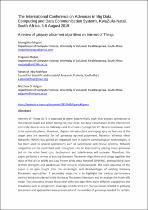JavaScript is disabled for your browser. Some features of this site may not work without it.
- ResearchSpace
- →
- Research Publications/Outputs
- →
- Conference Publications
- →
- View Item
| dc.contributor.author |
Mnguni, S

|
|
| dc.contributor.author |
Abu-Mahfouz, Adnan MI

|
|
| dc.contributor.author |
Mudali, P

|
|
| dc.contributor.author |
Adigun, MO

|
|
| dc.date.accessioned | 2019-11-18T05:54:02Z | |
| dc.date.available | 2019-11-18T05:54:02Z | |
| dc.date.issued | 2019-08 | |
| dc.identifier.citation | Mnguni, S., Abu-Mahfouz, A.M.I., Mudali, P. & Adigun, M.O. 2019. A Review of Gateway Placement Algorithms on Internet of Things. In: The International Conference on Advances in Big Data, Computing and Data Communication Systems, KwaZulu-Natal, South Africa, 5-6 August 2019 | en_US |
| dc.identifier.isbn | 978-1-5386-9236-3 | |
| dc.identifier.isbn | 978-1-5386-9237-0 | |
| dc.identifier.uri | https://ieeexplore.ieee.org/document/8851043 | |
| dc.identifier.uri | DOI: 10.1109/ICABCD.2019.8851043 | |
| dc.identifier.uri | http://hdl.handle.net/10204/11223 | |
| dc.description | Presented in: The International Conference on Advances in Big Data, Computing and Data Communication Systems, KwaZulu-Natal, South Africa, 5-6 August 2019. Due to copyright restrictions, the attached PDF file contains the abstract of the full-text item. For access to the full-text item, please consult the publisher's website. | en_US |
| dc.description.abstract | Internet of Things (IoT) is expected to grow exponentially such that devices connected to the internet reach 125 billion during the year 2030. For data transmission to the internet IoT end node devices rely on Gateways and to ensure coverage for IoT devices Gateways need to be optimally placed. However, physical infrastructure and topography as features of the target area are essential for IoT gateways optimal placement. Recently, Wireless Mesh Networks (WMN) has gained an important role in current communication technologies. It has been used in several applications such as surveillance and rescue systems. Network congestion can be minimized and throughput can be improved by placing many gateways but on the other hand cost, deployment and interference will increase. Therefore, this paper performs a review of existing Gateway Placement Algorithms and brings together the state-of-the-art in WMN and Low Power Wide Area Network (LPWAN), distinguishing each of their strengths and weaknesses that requires improvements. The main objective of this paper is to gain insight into the advantages and disadvantages of existing Gateway Placement approaches. A secondary objective is to highlight the various performance metrics being considered in the Gateway Placement literature and to analyze the trade-offs made. The conducted review shows that different algorithms have different capabilities and drawbacks such as congestion, coverage, interference etc. Various issues related to gateway placement and approaches were presented and the number of gateways needed for certain. | en_US |
| dc.language.iso | en | en_US |
| dc.publisher | IEEE | en_US |
| dc.relation.ispartofseries | Workflow;22751 | |
| dc.subject | Internet of Things | en_US |
| dc.subject | IoT | en_US |
| dc.subject | Gateway placement algorithms | en_US |
| dc.title | A review of gateway placement algorithms on Internet of Things | en_US |
| dc.type | Conference Presentation | en_US |
| dc.identifier.apacitation | Mnguni, S., Abu-Mahfouz, A. M., Mudali, P., & Adigun, M. (2019). A review of gateway placement algorithms on Internet of Things. IEEE. http://hdl.handle.net/10204/11223 | en_ZA |
| dc.identifier.chicagocitation | Mnguni, S, Adnan MI Abu-Mahfouz, P Mudali, and MO Adigun. "A review of gateway placement algorithms on Internet of Things." (2019): http://hdl.handle.net/10204/11223 | en_ZA |
| dc.identifier.vancouvercitation | Mnguni S, Abu-Mahfouz AM, Mudali P, Adigun M, A review of gateway placement algorithms on Internet of Things; IEEE; 2019. http://hdl.handle.net/10204/11223 . | en_ZA |
| dc.identifier.ris | TY - Conference Presentation AU - Mnguni, S AU - Abu-Mahfouz, Adnan MI AU - Mudali, P AU - Adigun, MO AB - Internet of Things (IoT) is expected to grow exponentially such that devices connected to the internet reach 125 billion during the year 2030. For data transmission to the internet IoT end node devices rely on Gateways and to ensure coverage for IoT devices Gateways need to be optimally placed. However, physical infrastructure and topography as features of the target area are essential for IoT gateways optimal placement. Recently, Wireless Mesh Networks (WMN) has gained an important role in current communication technologies. It has been used in several applications such as surveillance and rescue systems. Network congestion can be minimized and throughput can be improved by placing many gateways but on the other hand cost, deployment and interference will increase. Therefore, this paper performs a review of existing Gateway Placement Algorithms and brings together the state-of-the-art in WMN and Low Power Wide Area Network (LPWAN), distinguishing each of their strengths and weaknesses that requires improvements. The main objective of this paper is to gain insight into the advantages and disadvantages of existing Gateway Placement approaches. A secondary objective is to highlight the various performance metrics being considered in the Gateway Placement literature and to analyze the trade-offs made. The conducted review shows that different algorithms have different capabilities and drawbacks such as congestion, coverage, interference etc. Various issues related to gateway placement and approaches were presented and the number of gateways needed for certain. DA - 2019-08 DB - ResearchSpace DP - CSIR KW - Internet of Things KW - IoT KW - Gateway placement algorithms LK - https://researchspace.csir.co.za PY - 2019 SM - 978-1-5386-9236-3 SM - 978-1-5386-9237-0 T1 - A review of gateway placement algorithms on Internet of Things TI - A review of gateway placement algorithms on Internet of Things UR - http://hdl.handle.net/10204/11223 ER - | en_ZA |






